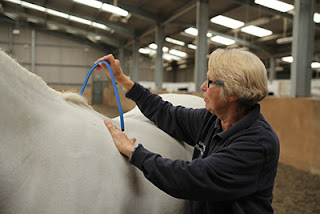There are many myths that have been going around with regards to saddlery and the use thereof. In this series of posts, I endeavour to show most of them are without foundations and can, in some cases, be the opposite of the actual facts.
Pictured left is author Kay Hastilow, Master Saddler and Master Saddle Fitter.
Companies
trying to sell their products have many ways to tempt us to become customers, sometimes
recommendations from well-known riders but more often nowadays we are seeing
claims stating the ‘research shows’ or something similar. Now, as any regular
followers will know, I am all in favour of proof and testing of products, but
all ‘research’ isn’t equal.
Proper believable research should have been undertaken using a fixed protocol so that the testing has been repeated and is repeatable in exactly the same way, coming up with the same results whosoever does this work.
All testing should be done with different horses and riders being tested in different combinations and in a different order, often over a number of days. Testing done with just one or two horses really isn’t anything more than information to be considered and should be treated as such. Work undertaken to be peer reviewed and published by the British Equine Veterinary Association is usually expected to use a minimum of 10 sound horses and several different riders over a number of days, dependant on the study being undertaken. Such work is truly believable whereas much that I see really hasn’t been ‘proven’ to my mind.
In any credible testing scenario, it is essential that the following guidelines have been followed:-
2. The equipment must be of a high enough resolution to be accurate, (in the case of pressure testing) and that equipment must have been scientifically and independently verified (as should any equipment being used in any research.) It should be video synched to the pressure testing as this is essential to interpreting what you have seen. (a horse tripping, for instance will show a change to the pressure readings).
3. It must have been ‘zeroed’ on the surface that is to be tested (the horse’s back) immediately before any testing being undertaken here, and then again for every different horse and rider combination.
4. The operator must be experienced enough to correctly interpret the results seen.
All are all necessary for any successful testing or research.
If you see claims being made for a product, or to try and establish a fact regarding horses / riders/ tack, please ask exactly what protocols were in place and what experience the operators of the testing equipment have. Do not be fobbed off with a statement such as ‘A study using a host of experts’ or the like. Ask for the full facts and, if they are not willing to share that information with you, ask yourself how much store you can put by their claims.
Watch a brief trailer and buy securely online at
https://vimeo.com/ondemand/saddlefittingknowhow

No comments:
Post a Comment